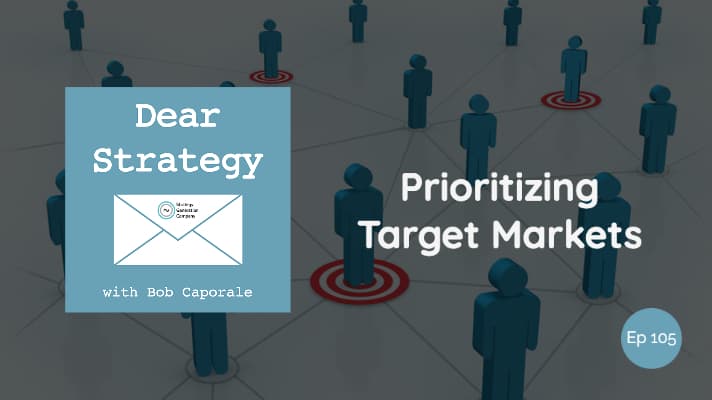On this episode of Dear Strategy, we answer the following question…
Dear Strategy:
“Which one comes first – market size or product capabilities that match the market?”
Short questions require short answers. And, in this case, here’s the shortest answer that I can give…
“Neither.”
Now, allow me to explain:
I’m not at all surprised by this question because, inside the corporate world, we have all been trained to choose our targeted markets based entirely on how attractive those markets are to our companies. That attractiveness can be measured in terms of the market itself (i.e. how big it is, how profitable it is, whether it’s growing or shrinking, etc.) or in terms of how viable our product solution might be within that market. The problem is that both of those approaches start with – you guessed it – what we want to do. And that, at least in my opinion, isn’t the right place to start at all.
All of this, of course, is in relation to determining which markets you want to target with your product or business strategy. So I’m going to make an assumption that we’re talking about an existing business with already established products and already established markets. The question, then, has to do with which markets this business should be thinking about actively pursuing in order to grow? And to do that analysis, I suggest taking these three factors into consideration – in order:
- Customer Needs – The very first thing you need to consider is the unmet needs that exist in the marketplace with respect to the types of products you are thinking about supplying. What you’re looking for are customer pain points and customer problems that are still in need of solutions. Understanding these needs will allow you to group (or segment) your customers accordingly, which is the first step in being able to evaluate which segments you actively wish to pursue.
- Market Attractiveness – Once you’ve established that there are unmet needs to be addressed, then you can go about the business of determining which market segments are likely to provide the greatest relative returns on your investment. You can determine this by analyzing some combination of the size, projected growth trends, and projected profitability of each segment that you are thinking about going after.
- Capabilities and Competition – Finally, you need to consider how capable you are of providing solutions to the problems that you identified in step 1 (i.e. the investments you’ll need to make), as well as how likely it is that you’ll be able to succeed within your chosen segments given whatever competition exists (or is likely to exist) in those segments already.
The key here is to make sure you consider all three of these factors, and that you prioritize them in the order shown above.
If you prioritize Item #2, for example, you’ll likely be chasing after markets based purely on their relative size, without any real concern for whether or not you have the capabilities to compete within those markets, and without any real regard for whether or not those markets are actually in need of whatever products or services you are trying to offer them.
Prioritizing on Item #3 creates an equally problematic scenario, with companies trying to push their products onto market segments that either didn’t want them, didn’t need them, or weren’t big enough to bother with in the first place.
That’s why, in my book, the only way to approach this exercise is in the order stated above: Make sure there is a need, make sure the need is big enough for you to address, and make sure you have the ability to address that need without being overrun.
“Make sure there is a need, make sure the need is big enough for you to address, and make sure you have the ability to address that need without being overrun.”
That should be straightforward enough – but there is one possible counterargument that I want to talk about before we go. That is – whenever I teach this subject, I invariably get at least one person in any given class who pushes back with some example of Steve Jobs and Apple “creating needs” in the marketplace that wouldn’t have otherwise existed. This is meant to provide the rationalization for skipping over Item #1. And as much as I love what Apple did as a company – particularly back in the late 1990s and early 2000s – I’m afraid I just don’t buy the argument that they actually created the need for anything that they introduced.
Just about every modern bit of technology that we currently hold in our hands was developed in response to needs that existed long before those products were ever developed. I remember visiting EPCOT center when it first opened as part of Walt Disney World back in 1982. At that time, there was an entire themed land that was dedicated to envisioning technologies that were not fully available at the time, but that are actually quite commonplace as I write this some 38 years later. And those technologies – such as remote communication devices, video phones, and high-tech personal computers running most every part of our lives – were envisioned based on needs that we all had at the time. Heck, even the TV comedy Get Smart envisioned many of those same solutions 15+ years prior to EPCOT ever existing! And the reason is that the needs that drove those conceptual solutions were always there. There just wasn’t any technology that existed to solve for those needs at the time.
The point is, most companies don’t create needs for anything. Instead, they create products to address needs that already exist. The needs might be outrageous, and there might be no feasible way to address those needs at every given point in time. But they are there. And the companies who can most accurately identify those needs, and then develop solutions to address those needs in ways that nobody else ever could – well, those are the companies that usually win.
So what comes first when determining which markets you should be targeting? Your customers. Remember that, and everything else should automatically fall into place.
Listen to the podcast episode
Dear Strategy: Episode 105

Are you interested in strategy workshops for your product, marketing, or business managers? If so, please be sure to visit Strategy Generation Company by clicking the link below:
 Bob Caporale is the founder of Strategy Generation Company, the author of Creative Strategy Generation and the host of the Dear Strategy podcast. You can learn more about his work by visiting bobcaporale.com.
Bob Caporale is the founder of Strategy Generation Company, the author of Creative Strategy Generation and the host of the Dear Strategy podcast. You can learn more about his work by visiting bobcaporale.com.






